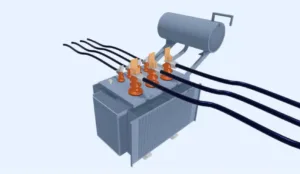Our world runs on electricity, and our knowledge is dominated by two basic forms of electrical currents. Ac current v/s Dc current.DC will be used in the majority of the digital gadgets you develop. Nonetheless, it’s critical to comprehend a few AC ideas. Since most homes are wired for air conditioning, you will need to convert air conditioning to DC if you intend to plug your Tardis music box project into an outlet. AC was selected as the main method of transmitting energy over long distances because it also possesses several beneficial qualities, such as the ability to change voltage levels with just one component (a transformer). 
Even though they both entail the flow of electric charge, they function differently and have unique uses and traits.
AC current: An electrical current known as alternating current (AC) occurs when the direction of electric charge flow alternates on a regular basis. There is a frequency at which this reversal happens, usually expressed in Hertz (Hz). The majority of the time, 50 or 60 Hz is the oscillation frequency of AC power in homes and businesses.
The ease with which AC electricity can be changed using transformers is one of its main benefits. This function allows voltage modification for a variety of applications and makes long-distance electricity transfer easier.The voltage and current in an AC circuit alternate sinusoidally, resulting in an oscillating waveform between positive and negative values. The sine wave, which is distinguished by its repeating, smooth pattern, is the most prevalent waveform for AC current.Around the world, homes and businesses are often supplied with AC power, which powers a wide range of appliances, lights, and other gadgets.
DC current: Electrical current that runs steadily in one direction is known as direct current, or DC. DC current keeps an electric charge flowing continuously, in contrast to AC current, which alternates direction on a regular basis.Batteries are one of the main sources of DC electricity. A consistent stream of DC electricity is produced by the battery’s internal chemical reactions, which cause electrons to flow in one direction.Unlike AC, DC voltage does not fluctuate over time, giving graphic representations of a flat line. Because of its simplicity, DC power is perfect for electronics like computers, mobile phones, and electrical circuits that need steady voltage levels.
While DC power suffers less loss over shorter distances, making it ideal for certain applications, notably within tight areas or localized power distribution systems, AC power is suitable for long-distance transmission.Important distinctions between DC and AC
Applications of Ac current v/s Dc current
Dc current
Direction of Current Flow: DC current flows continuously in one direction, whereas AC current alternates directions on a regular basis.
Characteristics of Voltage and Current: DC voltage is constant, but AC voltage and current oscillate sinusoidally.
Transmission and Distribution: DC electricity loses less energy over shorter distances, whereas AC power can be easily changed, making it more suited for long-distance transmission.
Applications: Lighting, appliances, and industrial machines are frequently powered by AC electricity in both residential and commercial settings. Electronics, battery-operated devices, and automobile systems all use DC power.
Ac current:
Power Distribution:
In homes, offices, and enterprises all around the world, AC power is the common type of electricity utilized for power distribution. Transformers’ ease of usage in converting AC voltage allows for effective transmission across great distances from power plants to end customers.
Home Appliances:
The majority of home appliances run on air conditioning (AC) power, such as air conditioners, refrigerators, washing machines, and televisions. These appliances can operate with dependability and efficiency because of the flexibility of AC voltage.
Industrial Machinery:
Because AC motors can provide large torque at different speeds, they are frequently utilized in industrial machinery and equipment. Heavy-duty applications, conveyor systems, and manufacturing processes all depend on AC-powered equipment in the industry.
Lighting Systems:
In homes, workplaces, and public areas, AC power serves as the main electrical source for lighting systems. AC voltage is necessary for the efficient operation of LED fixtures, fluorescent lights, incandescent bulbs, and other lighting technologies.
Integration of Renewable Energy Sources: AC power grids enable the integration of renewable energy sources like solar and wind power. The effective distribution and synchronization of power produced from various sources is made possible by AC systems, which enhances the stability and dependability of the electrical grid.
Uses of Dc current:
Electronics:
Digital cameras, laptops, tablets, and smartphone batteries all require DC electricity to operate. For these devices to function effectively, steady voltage levels from batteries or DC power supplies are needed.
Systems that Run on Batteries:
Batteries are a main source of direct current power and can store energy for a variety of uses, such as electric cars, portable devices, and backup power systems. Battery-powered DC power allows for freedom and mobility in powering equipment without requiring a constant connection to an external power source.
Automotive Systems:
The vehicle’s battery provides DC power for a number of automotive systems and components, including headlights, dashboard electronics, and starting motors. In contemporary cars, DC voltage guarantees the dependable operation of crucial components.
Photovoltaic Systems:
Using solar panels, solar photovoltaic (PV) systems turn sunlight into DC electricity. Inverters can be used to convert DC power from solar panels into AC power for off-grid or grid-tied applications, or the DC power can be utilized directly to power DC loads.
Telecommunications: Base stations, data centers, and cell towers all frequently require DC power as part of their infrastructure. During power outages, DC systems offer backup power to ensure that vital communication networks continue to function.
How to convert Ac current into Dc current:
There are several ways to convert alternating current (AC) to direct current (DC). Rectification is the process of allowing electricity to flow in just one direction in order to convert AC to DC. Usually, to accomplish this, diodes are arranged in a certain arrangement known as a rectifier circuit. Rectifiers come in two primary varieties:
Half-Wave Rectification: A half-wave rectifier produces pulsating DC output by allowing only half of the AC waveform to pass through. Though basic, this approach is ineffective.
Full-Wave Rectification: Compared to half-wave rectification, full-wave rectification produces a smoother output by converting both half of the AC waveform into DC. Bridge rectifiers are frequently used for full-wave rectification. They are made up of four diodes placed in a bridge arrangement.
Diode Bridge Rectifiers: As previously said, a diode bridge rectifier is made up of four diodes organized in a bridge form. This configuration guarantees that the output always points in the same direction, independent of the polarity of the AC input. In power supplies and electronic circuits, diode bridge rectifiers are frequently used to convert AC to DC.
Using Transformers and Rectifiers: An further technique entails stepping down the AC input voltage using transformers, then rectifying the output using diodes. This method is frequently used in power supply, where a transformer reduces the voltage to a level that is appropriate for rectification and further usage in electronic equipment.
Switch-Mode Power Supplies (SMPS): These power supplies are commonly used to effectively convert AC to DC. Unlike conventional linear power supply, they use semiconductors like transistors to alter the input voltage at high frequencies, enabling smaller transformers and capacitors. SMPS are widely used in computers, appliances, and other electronic equipment because of their small size and great efficiency.
History
Benjamin Franklin’s :
The foundation for our knowledge of the nature of electricity was established by Benjamin Franklin’s 18th-century experiments with lightning and static electricity. Franklin introduced the ideas of electrical conductivity and charge by demonstrating the relationship between lightning and electricity through his well-known kite experiment.
Alessandro Volta’s :
Alessandro Volta created the first real battery in 1800. The Voltaic pile was made up of copper and zinc discs that alternated, spaced by cardboard that had been dipped in seawater. Because of the chemical reactions between the metals and the electrolyte in this configuration, a constant flow of electric current was produced. With the development of a dependable electrical supply, Volta demonstrated the potential uses of electric current in real-world situations.
Michael Faraday’s Electromagnetic Induction:
The relationship between electric current and magnetic fields was first understood thanks to Faraday’s early 19th-century electromagnetic experiments. Faraday made the discovery of electromagnetic induction, which shows that an electric current can be induced in a conductor by a shifting magnetic field. Modern electrical technology was founded on the creation of electric generators and motors, which were made possible by this revolutionary discovery.
Samuel Morse’s Telegraph: By allowing messages to be sent across great distances practically immediately, Samuel Morse’s 19th-century invention of the telegraph transformed communication. The telegraph used Morse code to send encoded messages through wires that carried electric current. Modern telecommunications systems are based on the speed and efficiency of communication that Morse’s invention revolution.
Nikola Tesla:
The development of alternating current (AC) power systems by Nikola Tesla in the late 19th and early 20th centuries completely changed how electricity was produced and distributed. Long-distance power transmission is now feasible thanks to Tesla’s invention of AC induction motors and transformers, which outperform direct current (DC) methods. Tesla’s advancements in AC technology were essential to the global electrification of buildings, transportation networks, and industries.
6. Thomas Edison’s Incandescent Light Bulb: Thomas Edison revolutionized lighting in the late 19th century with the development of the incandescent light bulb. An electric current flowing through a carbonized bamboo filament was what allowed Edison’s lightbulb to emit light. Thanks to Edison’s innovation, electricity
Conclusion
By now, you must to be well-versed on the distinctions between AC and DC. Because AC is simpler to convert between voltage levels, high-voltage transmission becomes more practical. Conversely, DC is present in nearly all devices. You should be aware that the two do not mix well, and that in order to plug most equipment into a wall outlet, you must convert AC to DC. Now that you have this knowledge, even with AC-related topics and circuitry, you ought to be prepared to take on some more challenging material.


